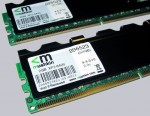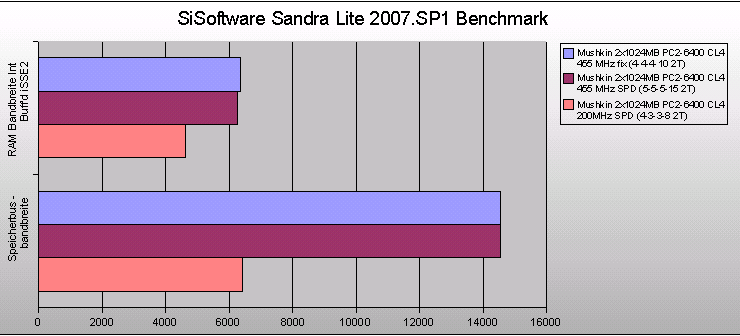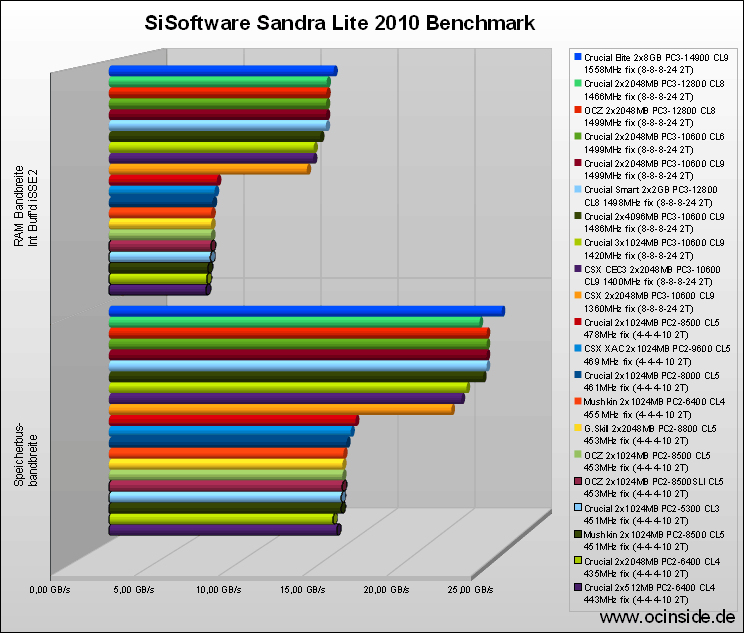
Let us begin with the most important part of the test report, because the optical characteristic and packing is of course rather secondary and the highest possible stable performance is the most important factor. CPU on different frequencies depending on the reference clock for the different memory benchmarks. Furthermore the memory modules were tested on another reference board to test the high frequency with higher voltages. The multiplier adjustment remains on 9x with all frequencies, because an adjustment for the CPU in half multiplier steps would be too inaccurate to get nearly the same CPU frequency for all tests.
Microsoft Windows XP Professional SP2 is used as the operating system. The stability was examined with the software Memtest86
and SiSoft Sandra Lite 2007.SP1 program is used for all benchmarks, since it offers extensive adjustments and a fast result comparison. BTW. the latest SiSoft Sandra 2008 version is available on our download server and can be downloaded much faster – ALL benchmarks are also included in the free Lite version.
First the maximum possible frequency of the memory module was determined. The memory frequency was increased in small steps with a fixed memory timing of 4-4-4-10 2T and default memory voltage, as long as the detailed memory test with Memtest86 runs without any errors. This quite long testing time ensured that this frequency works really stable with these modules.
The highest possible frequency with 4-4-4-10 (Tcl Trcd Tras Trp) timings was stable with enormously high 455 MHz.
It’s possible to run much higher frequencies with increased voltages or lower timings, because the frequency values and timings depends directly from each other. Officially Mushkin specify a memory voltage of 1.90 to 2.10 Volt without loosing the warranty. In view of the standard DDR2 memory voltage of 1.8 Volt one can obtain considerable results with 2.10 Volt, whereby it was possible in the test with 2.1V to get far above the 500 MHz hurdle. This isn’t possible on all motherboards, because on the one hand it is necessary that these high clock rates are supported by the motherboard and on the other hand it’s absolutely necessary to support this high memory voltage (Vmem) of approx. 2.0V – 2.1V. For this test additionally a slightly modified reference board (Foxconn C51XEM2AA) was used. Results of 600 MHz and above would come true with these Micron D9GMH memory chips on approx. 2.20 – 2.40 Volt. However, Mushkin doesn’t allow these voltages above 2.10 Volt officially, so you’ll loose the warranty.
The highest possible frequency with default DDR2 voltage was compared with two settings. On the one hand 455 MHz with SPD values (these are programmed in the SPD IC by the manufacturer), and on the other hand 200 MHz (x2) with SPD values.
By the way, the “Memory Bus Range” is no benchmark value, but this value is quite simple to calculate by the frequency and is useful for the benchmark comparison.
Here’re the benchmark results:
| Frequency | Timing | RAM Range Int Buff’d iSSE2 | Memory bus range |
| 455 MHz | fix (4-4-4-10 2T) | 6350 MB/s | 14560 MB/s |
| 455 MHz | SPD (5-5-5-15 2T) | 6264 MB/s | 14560 MB/s |
| 200 MHz | SPD (4-3-3-8 2T) | 4608 MB/s | 6432 MB/s |
Here’s a diagram of the benchmark values:

Here is a direct benchmark result comparison of some DDR2 and DDR memory modules:

The result of the Mushkin XP2-6400 modules with standard voltage was 4 MHz over the higher priced Mushkin XP2-8500 kit and shows, how close the results are in the upper range. As already often mentioned, the voltage of the memory modules is enormously important and that is also the difference to much more expensive high-end modules. These were tested with higher voltages and get the manufacturer approval for this voltage, frequency and latency. However, everyone can decide to overclock above manufacturers specification on their own risk in order to get much more performance for less money.

